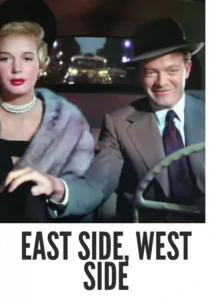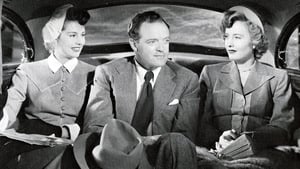Contact: info@alwanfilm.com
Video Sources 0 Views

Synopsis
East Side West Side 1949 Colorized Review: A Noir Classic of Glamour, Betrayal, and Revenge

Introduction
Released in 1949, East Side, West Side stands as a captivating entry in the realm of post-war noir cinema. Directed by Mervyn LeRoy and boasting a star-studded cast, this film delves into the complexities of love, betrayal, and redemption, set against the backdrop of the contrasting worlds of Manhattan’s elite. The film features notable performances by Barbara Stanwyck, James Mason, Ava Gardner, and Van Heflin, each of whom brings nuance and depth to their roles. As one of the early Hollywood movies to use color techniques sparingly while mainly employing black and white, East Side, West Side provides a riveting exploration of human nature that resonates even in today’s context.
This article explores the impact and enduring legacy of East Side, West Side, diving into its artistic nuances, character complexities, and its portrayal of 1940s Manhattan. We’ll also discuss how the selective colorization of certain scenes enhances the storytelling, making it a unique classic in the world of film noir.
Check The Full Colorized Movies List
Check Our Colorized Movies Trailer Channel
Understanding East Side West Side 1949 Colorized: Director, Cast, and Genre
Director’s Vision
Mervyn LeRoy, known for his work in genres ranging from crime dramas to romantic epics, brings a distinct blend of sophistication and grit to East Side, West Side. LeRoy was adept at capturing emotional tension and translating complex relationships onto the screen. In this film, he was particularly interested in exploring the effects of wealth, power, and betrayal on human relationships, diving deep into the psychology of his characters. LeRoy’s vision, combined with his understanding of the noir aesthetic, creates a film that is both visually appealing and narratively compelling.
The Iconic Performance of Actors
Barbara Stanwyck stars as Jessie Bourne, a strong-willed but vulnerable woman grappling with a turbulent marriage. Stanwyck’s performance is both graceful and intense, capturing Jessie’s internal struggle as she faces her husband’s infidelity. Stanwyck’s portrayal is nuanced, conveying Jessie’s resilience and her longing for genuine love and loyalty.
Opposite her, James Mason plays Brandon Bourne, Jessie’s unfaithful and morally ambiguous husband. Mason brings an air of sophistication and arrogance to Brandon, perfectly embodying the flawed and complex nature of his character. The cast also features Ava Gardner as Isabel Lorrison, Brandon’s former lover whose reappearance triggers the story’s main conflict. Gardner’s portrayal of Isabel is alluring yet dangerous, adding a layer of tension and intrigue to the film. Rounding out the central cast is Van Heflin as Mark Dwyer, a former police officer and friend of Jessie, whose integrity and compassion stand in contrast to Brandon’s character. Together, the ensemble cast brings depth to the narrative, each performance contributing to the film’s emotional impact.
Exploring the Noir Drama Genre
East Side, West Side is a quintessential noir drama, a genre known for its dark themes, morally ambiguous characters, and visual style that emphasizes shadows and contrasts. The film adheres to many of these conventions, exploring themes of betrayal, jealousy, and revenge. The urban setting of Manhattan serves as the perfect backdrop for the noir elements, with the city’s upper-crust neighborhoods contrasting starkly with its grittier areas, symbolizing the duality of human nature.
Exploring the World of East Side West Side 1949 Colorized: Plot and Characters
Detailed Synopsis
East Side, West Side opens with Jessie Bourne (Barbara Stanwyck) leading an ostensibly perfect life with her wealthy, charming husband, Brandon Bourne (James Mason). However, Jessie is deeply aware of Brandon’s infidelity and the persistent threat of his former lover, Isabel Lorrison (Ava Gardner), returning to their lives. The central conflict arises when Isabel indeed returns to Manhattan, seeking to rekindle her romance with Brandon. Despite Brandon’s promises to Jessie, he is drawn back into Isabel’s web of seduction, leading to a series of dramatic events that put his marriage at risk.
As Jessie struggles with her feelings of betrayal and heartbreak, she forms a bond with Mark Dwyer (Van Heflin), a former police officer who provides her with the emotional support she lacks in her marriage. Mark’s presence offers Jessie a glimpse of genuine kindness and loyalty, contrasting sharply with Brandon’s deceitful nature. The story reaches a climax when Isabel is found murdered, and Brandon becomes a suspect. As the mystery unravels, Jessie must confront her feelings for both Brandon and Mark, ultimately making a choice about her future.
Complex Protagonists and Memorable Supporting Characters
Each character in East Side, West Side is richly developed, with complex motivations and moral ambiguities. Jessie’s character is both strong and vulnerable, a woman torn between her loyalty to her husband and her desire for a more fulfilling relationship. Brandon’s character, meanwhile, is emblematic of self-destructive ambition, a man whose charm masks a deep-seated insecurity and weakness. Isabel, portrayed by Ava Gardner, is a classic femme fatale whose beauty and allure mask her manipulative tendencies. Mark Dwyer serves as the moral anchor of the story, a character whose integrity and compassion highlight the flaws of those around him.
The Art of Film Colorization
Understanding the Process
Film colorization in the 1940s was limited to select sequences or specific scenes, mainly to emphasize key moments or emotions. While East Side, West Side was predominantly a black-and-white film, color was occasionally added to specific scenes to heighten their impact. This selective use of color adds an artistic layer to the storytelling, drawing viewers’ attention to crucial details and enhancing the emotional weight of certain moments.
Development Over Time
The selective colorization seen in East Side, West Side is an early example of experimenting with color in film noir, a genre traditionally shot in black and white. Over time, colorization techniques evolved, allowing for greater integration and accuracy. Today, colorization can transform an entire film, but in East Side, West Side, the sparing use of color highlights key scenes, demonstrating how even minimal color can influence a film’s visual style.
Early Colored Films: A Brief History
Emergence of Early Colored Techniques
Color film emerged in the early 20th century with experimental techniques like hand-painting frames and later developed into more advanced methods like Technicolor. By the late 1940s, color films were gaining popularity, but black-and-white film noir continued to dominate due to its suitability for the genre’s dark themes. The selective colorization used in East Side, West Side is a testament to Hollywood’s early exploration of color techniques, adding depth to the visual storytelling.
East Side, West Side and Its Selective Use of Color
The Decision to Add Color
The decision to add color to certain scenes in East Side, West Side was likely motivated by a desire to heighten the dramatic tension and draw attention to specific details. Color is used sparingly but effectively, emphasizing moments of high emotional intensity or conflict. This selective colorization enhances the visual narrative, creating a unique viewing experience that distinguishes the film from other noir dramas of its time.
Impact on the Visual Narrative
The use of color in select scenes adds a sense of surrealism and intensity to East Side, West Side, making these moments stand out within the film’s largely monochromatic palette. This technique enhances the storytelling by visually highlighting pivotal scenes, such as Isabel’s seductive encounters with Brandon or Jessie’s moments of realization and decision.
The Debate Over Film Colorization
Controversy Surrounding Colorization
Film colorization has long been a controversial topic, particularly among film purists who argue that adding color can alter the original artistic intent. In the case of East Side, West Side, the selective use of color may be seen as a stylistic choice rather than a complete departure from the film’s original vision. While some argue that colorization diminishes the noir aesthetic, others believe it enhances the film’s emotional depth and accessibility.
Examining East Side West Side 1949 Colorized as a Partially Colored Film
Enhancement or Distraction?
The selective colorization of East Side, West Side enhances the viewing experience by drawing attention to crucial scenes without detracting from the film’s noir atmosphere. While the use of color may initially seem at odds with the black-and-white aesthetic, it ultimately serves to underscore the film’s emotional and dramatic highlights. For many viewers, the added color provides a new layer of engagement with the story, while purists may feel it detracts from the classic noir ambiance.
Influence and Legacy: East Side, West Side’s Impact on Cinema
The Trend of Noir Dramas
East Side, West Side contributed to the popularity of noir dramas, a genre that would go on to influence countless films and directors. Its success demonstrated the appeal of stories that delve into the darker aspects of human nature, inspiring filmmakers to explore similar themes of betrayal, ambition, and redemption. The film’s influence can be seen in later noir dramas, as well as in genres that deal with complex relationships and moral ambiguities.
Director’s Cinematic Legacy: Beyond East Side West Side 1949 Colorized
Mervyn LeRoy’s Influence
Mervyn LeRoy’s career extended well beyond East Side, West Side, encompassing a diverse range of films that showcased his versatility as a director. Known for his work on films like Little Caesar (1931) and Gypsy (1962), LeRoy made significant contributions to Hollywood cinema, helping to shape the industry and inspire future filmmakers. His ability to balance dramatic tension with rich character development is evident in East Side, West Side and continues to be celebrated in film studies.
Themes Explored in East Side West Side 1949 Colorized
Darkness, Betrayal, and Morality
East Side, West Side tackles dark themes that resonate with audiences, exploring betrayal, jealousy, and the quest for redemption. These themes add depth to the characters’ relationships and highlight the complexity of human emotions. The film’s focus on moral ambiguity and personal integrity aligns with the conventions of film noir, making it a compelling and thought-provoking experience.
Reception and Controversy Surrounding East Side West Side 1949 Colorized
Initial Reviews and Audience Reactions
Upon its release, East Side, West Side was praised for its strong performances, particularly Barbara Stanwyck’s portrayal of Jessie Bourne. However, the selective colorization sparked debate among critics, with some applauding the innovative approach and others questioning its impact on the film’s noir atmosphere.
Where to Watch East Side West Side 1949 Colorized Online
Today, East Side, West Side is available for streaming on platforms like Amazon Prime Video and Turner Classic Movies. DVD and Blu-ray editions of the film, including colorized scenes, are also available for purchase.
FAQs About East Side West Side 1949 Colorized
Q: What is the significance of the selective colorization in East Side, West Side?
A: The selective colorization emphasizes key moments, adding emotional depth and visual impact without detracting from the film’s noir aesthetic.
Q: Who directed East Side, West Side?
A: The film was directed by Mervyn LeRoy, a prominent filmmaker known for his work in multiple genres.
Q: What themes are explored in East Side, West Side?
A: The film explores themes of betrayal, jealousy, and redemption, making it a thought-provoking noir drama.
Conclusion
East Side, West Side (1949) remains a timeless classic, a noir drama that skillfully navigates the complexities of love, betrayal, and morality. Mervyn LeRoy’s direction, coupled with the stellar performances of Barbara Stanwyck, James Mason, Ava Gardner, and Van Heflin, ensures that the film remains engaging and thought-provoking. The selective colorization technique adds a unique layer to the storytelling, enhancing the emotional impact of key scenes while sparking discussions about artistic intent in film colorization. As a movie that explores the darker facets of human nature, East Side, West Side endures as a testament to the power of cinema to illuminate the complexities of the human heart.














